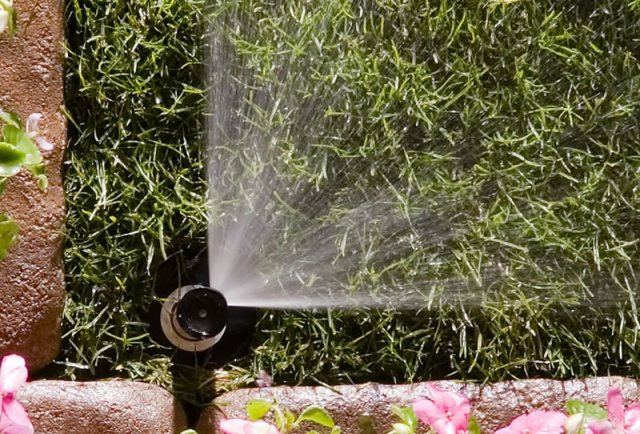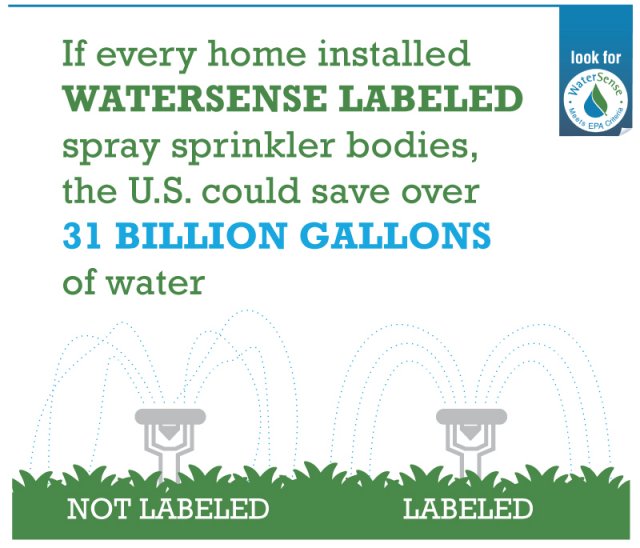Spray Sprinkler Bodies


Outdoor water use accounts for about 30 percent of average household water use nationwide. This number rises dramatically in hotter and drier parts of the country.
Current estimates are that residential outdoor water use accounts for nearly 8 billion gallons of water each day, mainly for landscape irrigation. Irrigation systems that operate at pressures higher than optimum levels can waste significant amounts of water.
On This Page:
Reduce Pressure
The sprinkler body is the exterior shell that connects to the irrigation system piping and houses the spray nozzle that applies water on the landscape. Some models of sprinkler bodies can control water pressure at the inlet to the nozzle, resulting in effective performance of their associated spray nozzles.

Landscape irrigation sprinklers are often installed at sites where the system pressure is higher than what is recommended for the sprinkler nozzle. This can lead to excessive flow rates, misting, fogging, and uneven coverage. WaterSense labeled spray sprinkler bodies with integral pressure regulation can reduce water waste by providing a constant flow at the sprinkler nozzle. Additionally, when the sprinkler body maintains a pressure near its optimal operating pressure, the connected nozzle is better able to generate the right amount of water spray and coverage for more uniform distribution of water across the landscape.
As with all WaterSense labeled products, spray sprinkler bodies must be tested and independently certified to ensure that they meet EPA’s criteria for efficiency and performance. This information is also available in a fact sheet (PDF)(1 pp, 399 K, About PDF). The mini-report, Relieve Pressure and Reduce Waste from Spray Sprinklers (4 pp, 1,440K , About PDF)also provides information about the features, benefits, and installation of WaterSense labeled spray sprinkler bodies.
WaterSense Savings

Installing WaterSense labeled spray sprinkler bodies in an irrigation system for the average household using 50,500 gallons outdoors, operating at or above 60 pounds per square inch (psi), can save nearly 5,600 gallons of water and $60 per year in water and sewer costs annually. Replacing all sprinkler bodies across the country that operate above optimal pressure with labeled models could save more than 31 billion gallons of water nationally each year.
Performance
EPA’s research indicated landscape irrigation sprinklers are often installed at sites where the system pressure is higher than recommended, which can lead to excessive flow rates, misting, fogging, and uneven coverage. EPA held off for several years on developing a specification until the industry developed a consensus-based ASABE/ICC 802 standard that it could reference that would address product performance and testing. Once a standard was available, EPA worked with several laboratories to validate the test method to determine if it was repeatable and reproducible and, as a result, identified modifications that were needed to resolve inconsistencies. EPA also tested various products on the market to identify the specific performance thresholds to include in its specification.
Spray sprinkler bodies that meet the WaterSense specification requirements have integral pressure regulation, allowing them to control water pressure and provide a constant flow at the nozzle, resulting in a reduction of excess flow out of the sprinkler when water pressure to the system is high. Additionally, they are better able to generate the right amount of water spray and coverage for more uniform distribution of water across the landscape because the sprinkler body maintains a pressure near its optimal operating pressure.
Specifically, WaterSense labeled spray sprinkler bodies are independently certified to meet performance requirements related to:
- Flow rate at various pressures: Assesses flow rate deviation at different pressures and ensures consistent flow rate at pressures higher than the manufacturer-specified regulation pressure for optimal nozzle performance.
- Outlet flow rate: Ensures the pressure across the sprinkler body (and subsequently the flow rate) do not drop such that it would impact performance.
See the Performance Overview for more information on how WaterSense assessed performance when developing the specification.
Specification
EPA released a final specification for WaterSense labeled spray sprinkler bodies on September 21, 2017.
- WaterSense Specification for Spray Sprinkler Bodies (PDF) (8 pp, 626 K, About PDF)
- WaterSense Specification for Spray Sprinkler Bodies Supporting Statement (PDF) (14 pp, 400 K, About PDF)
For more information about the specification development process for spray sprinkler bodies, including the draft specification, public response to the draft specification, and EPA's response to the public comments, please visit the Specification for Spray Sprinkler Bodies Background Materials page.
Manufacturers that produce spray sprinkler bodies meeting EPA's efficiency and performance criteria can apply to have their products certified to earn the WaterSense label. Before submitting products for testing, manufacturers must have a partnership agreement with EPA in place. Visit the manufacturer section on the partner page to learn more.
